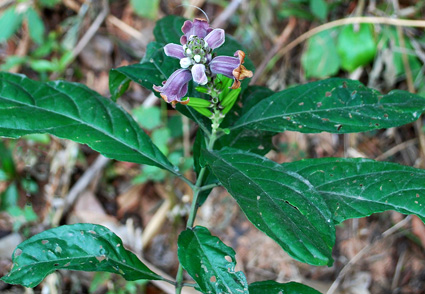Abstract
The present work is an effort to untangle the taxonomy of Phlogacanthus pulcherrimus, a poorly known species reported here for the first time for the flora of Vietnam. Fresh specimens of this species were collected from three localities in Southern Vietnam. They provided new insights to its appearance and morphology. Phlogacanthus pulcherrimus can be distinguished from the morphologically close P. geoffrayi and P. turgidus by oblanceolate-obovate, light to dark purple flower-subtending bracts, oblanceolate bracteoles, and staminodes 1 mm long. The corolla of the Vietnamese specimens of P. pulcherrimus is uniformly dark purple outside. A detailed description, photographs, and information on habitat, ecology and distribution of P. pulcherrimus are provided. Typification of this name is performed, and a specimen at K (K000885620) is designated as a lectotype.
References
Benoist, R. (1928) Acanthacées nouvelles asiatiques. Bulletin de la Société Botanique de France 74: 907–912. https://doi.org/10.1080/00378941.1927.10837070
Benoist, R. (1935) Acanthacées. In: Lecomte, M.H. (Ed.) Flore Générale de l’Indochine 4. Masson et Cie, Paris, pp. 610–772.
Clarke, C.B. (1885) Acanthaceae. In: Hooker, J.D. (Ed.) Flora of British India 4. L. Reeve, London, pp. 387–558. https://doi.org/10.5962/bhl.title.678
Dutta, B., Sarma, J. & Borthakur, S.K. (2016) Diversity and ethnobotany of the genus Phlogacanthus Nees in Assam, India. International Journal of Life-Sciences Scientific Research 2 (4): 472–477. https://doi.org/10.21276/ijlssr.2016.2.4.25
GBIF (2020) The Global Biodiversity Information Facility. Available from: https://www.gbif.org/ (accessed 20 July 2020)
Hai, D.V., Mai, N.T., Huong, N.T.T., Choudhary, R.K. & Deng, Y.F. (2018) An updated taxonomy of the genus Phlogacanthus (Acanthaceae) in Vietnam. Phytotaxa 372 (2): 167–175. https://doi.org/10.11646/phytotaxa.372.2.3
Hai, D.V., Hoan, D.T. & Choudhary, R.K. (2020) Phlogacanthus geoffrayi Benoist (Acanthaceae): a new record to the flora of Vietnam. VNU Journal of Science: Natural Sciences and Technology 36 (2): 49–53. https://doi.org/10.25073/2588-1140/vnunst.4962
Ho, P.H. (2000) Acanthaceae In: Ho, P.H. (Ed.) Cây c? Vi?t Nam – An Illustrated Flora of Vietnam 3. Tre Publishing House, Ho Chi Minh City, pp. 30–82.
Hooker, J.D. (1873) Meninia turgida. Curtis’s Botanical Magazine 99: tab. 6043.
Hu, C.C. (2002) Cystacanthus, Phlogacanthus. In: Hu, C.C. (Ed.) Flora Reipublicae Popularis Sinicae 70. Science Press, Beijing, pp. 207–214.
Hu, C.C. & Fu, X.P. (2005) Acanthaceae. In: Fu, L.K. & Hong, T. (Eds.) Higher plants of China 10. Qingdao Publishing House, Qingdao, pp. 329–416.
Hu, J.Q., Deng, Y.F. & Daniel, T.F. (2011) Cystacanthus, Phlogacanthus. In: Wu, Z.Y., Raven, P.H. & Hong, D.Y. (Eds.) Flora of China 19. Science Press, Beijing & Missouri Botanical Garden Press, St. Louis, pp. 474–477.
Imlay, J.B. (1939) Contributions to the flora of Siam. Additamentum LI. New and Re-named Siamese Acanthaceae. Bulletin of Miscellaneous Information (Royal Gardens, Kew) 1939: 109–150. https://doi.org/10.2307/4111677
Jain, S.K. & Rao, R.R. (1977) A Handbook of Field and Herbarium Methods. Today and Tomorrow’s Printers and Publishers, New Delhi, 157 pp.
Lien, T.K. (2005) Acanthaceae. In: Ban, N.T. (Ed.) Checklist of plant species of Vietnam 3. Agricultural Publishing House, Hanoi, pp. 251–281.
Lindau, G. (1900) Phlogacanthus turgidus. In: Urban, I. (Ed.) Symbolae Antillanae seu Fundamenta Florae Indiae Occidentalis 2 (2). Fratres Borntraeger, Lipsia, p. 211.
Nees von Esenbeck, C.G. (1832) Acanthaceae Indiae Orientalis. In: Wallich, N. (Ed.) Plantae Asiaticae Rariores 3. Treuttel, Würtz & Richter, London, pp. 70–112. https://doi.org/10.5962/bhl.title.468
Nees von Esenbeck, C.G. (1847) Acanthaceae. In: De Candolle, A.L.P.P. (Ed.) Prodromus Systematis Naturalis Regni Vegetabilis 11. V. Masson, Paris, pp. 46–519. https://doi.org/10.5962/bhl.title.286
POWO (2019) Phlogacanthus. Available from: http://powo.science.kew.org (accessed 20 July 2020)
Roskov, Y., Ower, G., Orrell, T., Nicolson, D., Bailly, N., Kirk, P.M., Bourgoin, T., DeWalt, R.E., Decock, W., Nieukerken, E. van, Zarucchi, J. & Penev, L. (Eds.) (2019) Species 2000 & ITIS Catalogue of Life, 2019 Annual Checklist. Digital resource at www.catalogueoflife.org/annual-checklist/2019. Species 2000. Naturalis, Leiden. ISSN 2405-884X (accessed 20 July 2020)
Seregin, A. (Ed.) (2020) Moscow University Herbarium (MW). Version 1.131. Lomonosov Moscow State University, Moscow. Available from: https://www.gbif.org/dataset/902c8fe7-8f38-45b0-854e-c324fed36303 (accessed 7 May 2020) https://doi.org/10.15468/cpnhcc
Somprasong, W., Vjarodaya, S. & Chayamarit, K. (2014) Taxonomic study of the family Acanthaceae used as traditional medicinal plants for ethnic groups in North, Central and Northeastern Thailand. Thai Agricultural Research Journal 32 (1): 77–88.
Somprasong, W., Vajrodaya, S. & Chayamarit, K. (2015) Taxonomic study of the subtribe Andrographinae, tribe Ruellieae, family Acanthaceae in Thailand. Thai Agricultural Research Journal 33 (1): 85–97.
Turland, N.J., Wiersema, J.H., Barrie, F.R., Greuter, W., Hawksworth, D.L., Herendeen, P.S., Knapp, S., Kusber, W.-H., Li, D.-Z., Marhold, K., May, T.W., McNeill, J., Monro, A.M., Prado, J., Price, M.J. & Smith, G.F. (Eds.) (2018) International Code of Nomenclature for algae, fungi, and plants (Shenzhen Code) adopted by the Nineteenth International Botanical Congress Shenzhen, China, July 2017. Regnum Vegetabile 159. Koeltz Botanical Books, Glashütten. https://doi.org/10.12705/Code.2018
Xia, C. & Deng, Y.F. (2013) Phlogacanthus yangtsekiangensis, a new combination in Chinese Acanthaceae. Phytotaxa 104 (1): 58–60. https://doi.org/10.11646/phytotaxa.104.1.9
WFO (2000) Phlogacanthus pulcherrimus T.Anderson, World Flora Online, published on the Internet. Available from: http://www.worldfloraonline.org/taxon/wfo-0000393473 (accessed 20 July 2020)
Wood, J.R.I. (1994) Notes relating to the Flora of Bhutan: XXIX. Acanthaceae, with special reference to Strobilanthes. Edinburgh Journal of Botany 51 (2): 175–273. https://doi.org/10.1017/S0960428600000871


